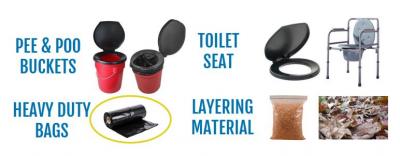The Two-Bucket Toilet Solution
In 2016, the Regional Disaster Preparedness Organization (RDPO) formed a multi-jurisdictional, multi-disciplinary task force to address regional sanitation needs following a catastrophic earthquake (or other event that disables sewer systems).
In the event of an emergency, their report noted, methods used for handling human waste in the absence of a functional wastewater system would need to be simple to adopt and inexpensive to implement. Most importantly, they must effectively protect public health by limiting exposure to waste.
Those with a working septic system would be the envy of neighbors in the event of an emergency. The rest of us would benefit by being prepared to implement “the Two-Bucket System.”
This easy, inexpensive solution requires that households have the following items on hand:
- Two large buckets
- Toilet paper
- Heavy-duty 13-gallon garbage bags (0.9 mil or thicker)
- Layering material, such as bark chips, leaves or sawdust
- A toilet seat (optional, but highly recommended).
Bucket #1 is for …. well, … your #1. And Bucket #2. You guessed it! Separating pee and poo reduces disease risks and odor and makes much easier to dispose of. Urine is (usually) sterile, while poop contains pathogens requiring special handling.
The premise is simple:
- When peeing: Use bucket #1, put paper in bucket #2. Urine (diluted with water when possible) can be easily disposed by pouring into dirt or lawn.
- When pooing: Line bucket #2 with a garbage bag, go about your business and cover with layering materials (to absorb moisture, reduce odor, and deter flies). When the bucket is half-full, double bag your waste and store it away from food, water, pets, flies, rats, etc.
And, of course, remember that emergency toilet options require good sanitation practices. Hand sanitizer is fine in a pinch, but the most effective way to stay clean is using soap and water.
For more detail, visit EmergencyToilet.org.





